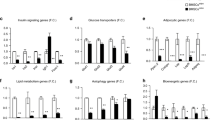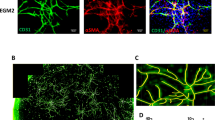Abstract
OBJECTIVE: The purpose of this study was to determine if the antiobesity actions of dehydroepiandrosterone (DHEA) observed in vivo are due to an influence on the proliferation and differentiation of primary cultures of stromal-vascular (SV) cells isolated from human adipose tissue.
DESIGN: SV cells were isolated from subcutaneous adipose tissue obtained from a young adult female undergoing elective liposuction. For the proliferation assay (Experiment 1), cultures were fed proliferation media containing 0, 5, 25 or 100 μM DHEA for 3 d. At the end of this treatment period, cultures were either prepared for counting or for determining their metabolic activity using the Alamar Blue staining procedure. For the differentiation assays (Experiment 2), cultures were fed differentiation media containing 0, 25 or 50 μM DHEA for 20 d. At the end of this treatment period, cultures were either prepared for lipid staining using Oil Red O or for marker enzyme analysis (glycerol-3-phosphate dehydrogenase activity; GPDH). To determine if the stimulatory effects of DHEA on SV cell differentiation were dependent on the presence of thiazolidinediones (Experiment 3), cultures of differentiating SV cells were incubated in the presence and absence of BRL 49653 and either 0, 25 or 50 μM DHEA.
RESULTS: In Experiment 1, cultures treated with 25 and 100 μM DHEA had fewer cells than cultures treated with either 0 or 5 μM DHEA. Alamar Blue staining decreased as the level of DHEA in the cultures increased. In Experiment 2, cultures treated with DHEA had more lipid and GPDH activity than control cultures. In Experiment 3, cultures treated with BRL 49653 had more triglyceride than cultures treated without BRL 49653. Likewise, cultures treated with DHEA had more triglyceride than their non-DHEA controls. Regardless of the BRL status, cultures supplemented with DHEA had more triglyceride than control cultures.
CONCLUSION: These data suggest that in cultures of SV cells from human adipose tissue, DHEA supplementation attenuates proliferation and enhances differentiation. These data support the hypothesis that DHEA directly attenuates preadipocyte proliferation in humans as we previously demonstrated in primary cultures of pig and rat SV cells and in cultures of 3T3-L1 preadipocytes. In contrast, DHEA stimulated the differentiation of human preadipocytes, which is contrary to its actions in differentiating cultures of preadipocytes from animals.
This is a preview of subscription content, access via your institution
Access options
Subscribe to this journal
Receive 12 print issues and online access
$259.00 per year
only $21.58 per issue
Buy this article
- Purchase on Springer Link
- Instant access to full article PDF
Prices may be subject to local taxes which are calculated during checkout
Similar content being viewed by others
Author information
Authors and Affiliations
Corresponding author
Rights and permissions
About this article
Cite this article
McIntosh, M., Lea-Currie, Y., Geigerman, C. et al. Dehydroepiandrosterone alters the growth of stromal vascular cells from human adipose tissue. Int J Obes 23, 595–602 (1999). https://doi.org/10.1038/sj.ijo.0800874
Received:
Revised:
Accepted:
Published:
Issue Date:
DOI: https://doi.org/10.1038/sj.ijo.0800874
Keywords
This article is cited by
-
Dehydroepiandrosterone Behavior and Lipid Profile in Non-Obese Women undergoing Abdominoplasty
Obesity Surgery (2007)
-
Dehydroepiandrosterone and human adipose tissue
Journal of Endocrinological Investigation (2006)
-
Trans-10,Cis-12 conjugated linoleic acid reduces triglyceride content while differentially affecting peroxisome proliferator activated receptor γ2 and aP2 expression in 3T3-L1 preadipocytes
Lipids (2001)
-
Conjugated linoleic acid suppresses triglyceride accumulation and induces apoptosis in 3T3-L1 preadipocytes
Lipids (2000)



